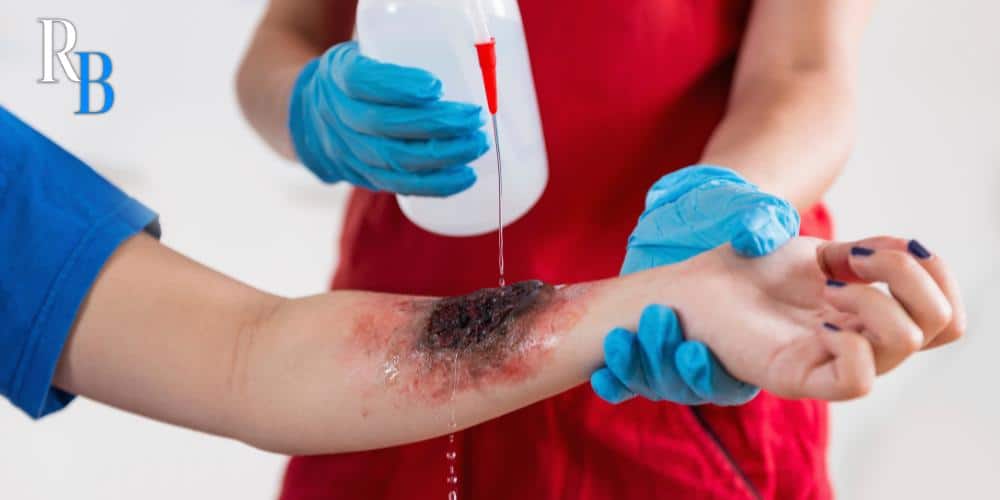Houston Burn Injury Attorney
PRACTICE AREAS
Top Houston, Texas Burn Injury Lawyers

If you or a family member received serious burn injuries due to someone else’s negligence, you need a legal team that knows how to effectively establish the full and fair value of your case in litigation. You need legal representation that grasps the hardships you face and knows how to protect your future. Simply put, you need a Houston burn injury attorney with Reich & Binstock.
Burns are serious injuries that have the potential to change someone’s life forever. Burn victims are often left with severe scarring, pain, and even trauma associated with the incident that caused their burns. At Reich & Binstock, we believe burn victims deserve full and fair compensation for the pain and suffering they have endured.
If you or someone you love suffered a severe burn injury due to someone else’s negligence, we’re here for you. Schedule a free, no-obligation consultation with us today by calling 713-622-7271 or submitting an online intake form.
Burn Injury Statistics
According to the American Burn Association, approximately 486,000 burn injuries occurred that received medical treatment in 2016. Additionally, 3,275 deaths occurred due to fire or smoke inhalation. One civilian loses their life to a fire every two hours and forty-one minutes. There were also approximately 40,000 hospitalizations related to burn injuries, including 30,000 at hospital burn centers.
This not only goes to show how common burn injuries are, but also how serious and life-threatening they can be. Burn injuries are traumatic and often involve physical, financial, and emotional damages. Even though burns are far from the most common causes of death, this makes them no less serious for victims and their families.
What Are the Common Causes of Burn Injuries?
There are numerous ways that a person may receive a burn injury, including car accidents, workplace accidents, defective products, premises liability issues, scalding injuries, chemical burns, and electrical burns.
Car Accidents
Motor vehicles, while equipped with many safety features in the modern age, still largely run on highly flammable and combustible materials like gasoline and oil. Many vehicles also contain large amounts of plastics and rubbers, which melt at high temperatures. If an explosion occurs during or after a Houston car accident, a victim can suffer severe burns or fatal injuries.
Workplace Accidents
Many different employees have inherently dangerous working conditions, such as those in construction zones, industrial plants, and on oil and gas rigs. These workers often come into close contact with strong, corrosive chemicals, electricity, and flammable or combustible materials. If someone is negligent on such a dangerous job site, this may lead to an accident that causes serious burns.
Defective Products
Electronics, appliances, and even e-cigarettes have been known to short-circuit, catch fire, or explode if they are defective. When this happens, consumers could suffer serious burns and other injuries. Victims should contact a Houston product liability attorney for representation.
Premises Liability
Owners and managers of certain properties, such as apartments, stores, businesses, and public spaces, must ensure their properties are safe for visitors and invitees. If an owner or manager of a property fails to maintain working fire alarms or sprinkler systems, they may be held liable for victims’ injuries in a premises liability lawsuit. Contact a Houston premises liability lawyer about your case as soon as possible.
Scalding Injuries
When an extremely hot liquid, such as boiling water, comes into contact with the skin, it can cause injuries known as scalding burns. Many young children experience scalding burns due to accidents in the kitchen, but they can also occur in places with steam release valves and other sources of hot liquids or steam.
Chemical Burns
Houston, Texas is known for its high concentration of petrochemical refineries. At these refineries, workers often handle industrial-strength chemicals and acids for their work. When these chemicals are not stored or handled properly, an accident could lead to a serious chemical burn.
Electrical Burns
As we’ve already mentioned, even electronics can be sources of burns. If something short circuits or causes an electrical shock, this can lead to a burn injury. Additionally, electrical burns are notorious for causing internal organ damage and cardiac issues.
Smoke Inhalation Injuries
The leading cause of death as a result of fires is not the fire itself, but rather the inhalation of smoke from the fire. Smoke inhalation can cause serious, often fatal, injury to the upper airway. In addition to smoke inhalation, breathing in toxic fumes from chemical fires can also be deadly.
Inhalation injuries cause significant damage to the respiratory system and lungs. These injuries can result from the breathing of toxic substances such as smoke, chemicals, particle pollution, and gases.
Those with chronic heart or lung problems such as asthma are especially prone to inhalation injuries caused by fires.
Industrial Burns from Chemical Plant Explosions, Oil Refinery Fires, Etc.
Plant and refinery workers are at a high risk of explosion injuries every time they go to work. When these explosions do occur, the results can be catastrophic. If the force of the blast from an explosion does not kill those near the explosion, the victims will likely suffer from devastating industrial burns.
In Texas, chemical plants and oil refineries are seemingly everywhere. Many workers here are subject to this environment as part of their daily work routine, so fellow Texans face a constant threat of explosion. The injuries received as a result can be life-altering, often bringing permanent disabilities. If you or a loved one received injuries from an explosion such as this, you need a Houston burn injury attorney ASAP.
How Do I Know if My Burn Injury is Serious and Permanent?

The severity of a burn is assessed in a few ways: burn degree, burn size, burn type, and burn location.
Burn Degree
The first way we assess a burn injury is the degree of the burn. Whether it’s a first, second, or third-degree burn is one of the most obvious ways of categorizing the severity of it. Third-degree burns are the most detrimental and often leave the victim with permanent damage.
First-Degree Burns
First-degree burns are considered to be minor and are the least severe of the three degrees. These burns typically heal within a week, as they only damage the first, outer layer of skin (the epidermis). First-degree burn injuries result in mild pain and discomfort, swelling, and reddening of the skin. A common example of this might be the average sunburn.
Symptoms of first-degree burns include:
- Dry skin
- Redness
- Skin that’s painful to the touch
- Peeling skin
Second-Degree Burns
Second-degree burns damage both the first layer of skin (epidermis) and the second layer of skin (dermis). Victims of second-degree burns typically experience severe pain, blisters, scarring, and whitening of the skin. Skin grafts may be required to properly treat these types of wounds.
Symptoms of second-degree burns include:
- Deeper redness
- Blisters
- Skin tenderness and pain
- Wet and shiny appearance of the burned area
- White or discolored skin of burned area
Third-Degree Burns
Third-degree burns are the most severe type of burn injury. These burns not only damage, but completely destroy both the epidermis and dermis. This poses even more risks for the victim because when the first and second layers of skin are burned through, the body is exposed to things like bacteria, viruses, and toxins. This increases the risk for infection.
A third-degree burn may leave skin appearing dry, leathery, and charred in the affected areas. It also may cause nerve damage to the victim. Treatment for these injuries almost always require skin grafts, using natural and artificial skin to protect the open wound and promote healing.
Symptoms of third-degree burns include:
- Dry, leathery skin
- White, yellow, brown, or black skin
- No pain, as the nerve endings were burned away
- Swelling
Fourth-Degree Burn
Fourth-degree burns are considered very severe burn injuries. While many people don’t know about fourth-degree burns, they are the highest level of burns. In fact, they are often life-threatening and can affect skin, muscles, tendons, and bones. If someone succumbs to their injuries that were caused by someone else’s negligence, their surviving family members could file a wrongful death claim.
Symptoms of fourth-degree burns include:
- Charred appearance of the skin
- Exposed muscle tissue or bone
- No pain, as the nerve endings have burned away
Burn Size
The next factor is the size of the burn. This is calculated by the percentage of skin that is burned. Clinicians use a formula to calculate the total body surface area (or TBSA) that is burned by taking into account the age of the injured person as well as a diagram known as the Rule of Nines. This is the most common way to estimate burn size and is only used for second and third-degree burns.
Burn Type
Burns injuries occur when a person’s tissue is damaged by heat or fire, exposure to chemicals, or electrical shocks. These injuries are more formally known as thermal burns, chemical burns, and electrical burns. Each type of burn is different in nature, but each is capable of causing any one of the three degrees of burns.
Thermal Burns
Thermal burns are the most common type of burn injury. They are a result of hot objects, including flames, steam, or scalding liquids, coming in direct contact with skin.
Chemical Burns
Chemical burns, on the other hand, are caused by chemicals that have strong bases or acids. These burns can be particularly dangerous because the chemical will continue to burn the body until it is completely removed. The eyes are especially sensitive to chemical burns; victims risk going blind if the chemical in question is not efficiently flushed from the eye area.
Electrical Burns
Electrical burns are a result of electrical currents coming in contact with the body. The severity or degree of the burn depends on how long one is exposed to this current. A high level of electrical shock or burns can cause permanent damage to the skin and major organs.
Other Burn Factors
Other factors that can help you determine the seriousness of your burn injury include:
- Location of the burn (Where the burn occurred on your body)
- Whether there was a smoke inhalation injury
- Previous health issues
A doctor will take into account all of these factors to estimate the severity and potential permanence of your burn injury.
What Is Recovery Like After a Burn Injury?

Burn injury victims often have a long, painful road to recovery. Burns usually require immediate medical treatment to ensure the chance of serious complications and infections are minimized. Most mild burns can start healing within a week. However, severe burns often require weeks or months of healing. In the worst cases, grafted or ungrafted burns may even take a year or longer to fully heal.
Different degrees and types of burns require different treatments. The healing process begins with letting the skin heal and fill in the burned area. Bandages and skin grafts are sometimes necessary. Once the skin has healed and closed, it must be moisturized.
If scarring occurs, physical therapy may help the victim recover their range of motion. If you or someone you love suffered a burn due to someone else’s negligence, contact a burn injury lawyer Houston as soon as possible.
What Are the Time Limits for Filing a Burn Injury Claim in Texas?
If you seek to file a burn injury claim in Texas, you only have a limited amount of time to do so following the accident that caused the injury.
Each state has their own statute of limitations for the time a claimant can pursue a legal remedy for their injury.
In the state of Texas, a victim has two years from the occurrence of the injury to file a lawsuit against the responsible party. However, it is best to contact a Houston personal injury lawyer to file your burn injury claim as soon as possible following the incident so as to ensure the evidence is fresh and your claim is handled properly from the beginning.
How Do I Get Compensation for My Burn Injuries?

The best way to ensure you receive proper compensation for your burn injuries is to attain help from an experienced Houston burn injury attorney.
Consulting with a qualified injury attorney can make all the difference in the outcome of your case. At Reich & Binstock, our burn injury attorneys work tirelessly to make sure you receive the maximum compensation for your burn injury case.
We offer personalized and aggressive representation throughout the entire legal process.
What Compensation Can I Recover in a Burn Injury Lawsuit?
In a burn injury lawsuit, compensation can include medical expenses, lost wages, pain and suffering, rehabilitation costs, and potentially punitive damages, depending on the circumstances of the case and the severity of the injuries. A Houston burn injury lawyer will help you fight for maximum compensation in your case.
FAQs for Burn Injury Cases
What Are Landlord and Smoke Detector Obligations in Texas?
According to the Texas Property Code (§92.251 – §92.262, Subchapter F), all landlords are required to equip their rental units with smoke detectors to protect their tenants from the possibility of a fire. This includes all apartments, duplexes, condos, and single-family homes.
At least one smoke detector must be installed outside of every bedroom in the unit. If the bedrooms share a corridor, a single smoke detector can cover them both so long as it is in the immediate vicinity of both rooms.
The landlord is obligated to inspect and repair any defective smoke detectors when a tenant first moves in. They are also responsible for inspecting them any time a tenant makes a request or gives notice of a potential problem. If the landlord fails to install, inspect, or repair a smoke alarm within 7 days of receiving written notice from a tenant, the tenant may exercise legal remedies under the Smoke Detector Subchapter of the Texas Property Code.
Do I Need a Lawyer for a Burn Injury Lawsuit?
Yes, seeking legal representation from a lawyer experienced in personal injury law is highly recommended for a burn injury lawsuit. Our Houston burn injury attorneys can navigate complex legal processes, advocate for your rights, assess your case’s strength, and work to secure fair compensation on your behalf.
Why Choose Reich & Binstock for Your Burn Injury Case?
The experienced burn injury attorneys at Reich & Binstock have decades of practice helping victims file claims against the negligent parties who are responsible for their injuries. Burns are extremely painful, and they often require extensive medical treatment and long recovery times. With our extensive knowledge of personal injury law in Texas, we’ll give you the support and guidance you need for your claim, all while gathering evidence and building a strong case on your behalf.
Experienced Houston Burn Injury Lawyers
If you wish to file a burn injury claim, let us help you. At Reich & Binstock, our lawyers offer free, no-obligation consultations, meaning you only pay if we recover compensation for your claim. Please call our Houston office at 713-622-7271 or complete our online form for a free case evaluation.
There is never a fee unless we recover on your behalf.
Additionally, clients are not obligated to pay expenses if a recovery is not made.













